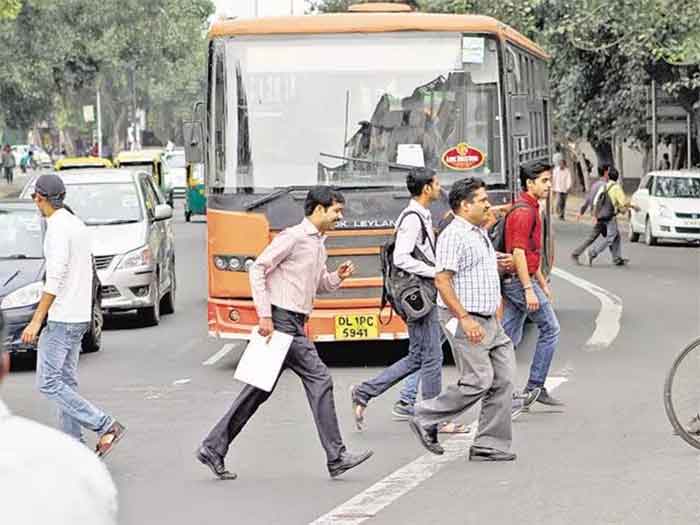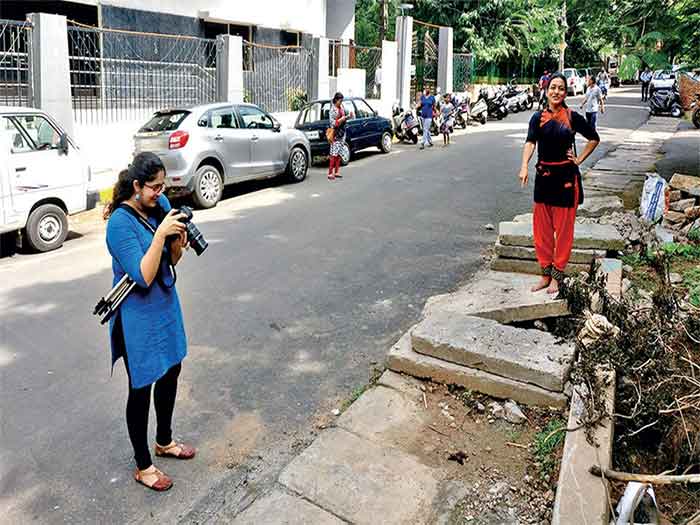
The poor are often unfairly blamed for straining Mumbai’s infrastructure, making it dirty.In fact, it can be argued that It is the rich who are in good measure responsible for making it dirty, consuming most of the land, grabbing more and more of it from the poor, causing severe road congestion and air pollution with their cars. One has only to walk and see the reality, you miss the reality from the comfort of the car..
Mumbai is now becoming an automobile slum. This is no exaggeration. This is a well accepted term, phenomenon in the United States where the blight caused by indiscriminate car use is seen as automobile slum. I have enough references on this.
Abandoned, broken down, dirt laden cars on roads are disfiguring the city. I see this sight daily on upscale Manuel Gonsalves road in Bandra for example. An abandoned car is covered with a dirty cloth and bricks are put on it so that it does not blown away, the same as we see on top of shanties. The owner lives in an adjoining building, other citizens don’t complain and this in locality where the citizens committee is supposed to be active. When offenders belong to the same upper class, no one raises an objection. Cars parked free on the road also provide a shelter for peeing and worse on the roadside, adding to the slum effect.
Now there is a new menace caused by big builders. Their huge tankers of cement concrete mixing are a visual menace and traffic hazard, they are operated on the road with impunity outside huge construction sites. So the builder makes all the money and the price is paid by ordinary people .
Land occupied by the poor in Mumbai and other cities is minimal, so is their water consumption. The poor may look dirty and undesirable for some people but they are not the cause of ugliness. Ugliness caused by bad architecture and other aspects is far bigger.
Also responsible for the mess to a good extent are the city and state administrations, politicians, the civil society and architects, among others. How can Mumbai be inclusive when its guardian minister Mangal Prabhat Lodha is a big builder known for building gated communities for the wealthy ? I saw one of his in the former cotton mill district with a number of swimming pools over a large area, one of them reserved for whites only. Yes, you read it right. I have seen the rise of the hefty, meek looking gentleman, from a small time builder he was 30 years ago.
For the common man slums are hardly visible during day to day activities. Gone are the days when the road to the airport used to be lined with the poor sitting in the morning in the absence of public toilets. But shanties are an eye sore for the rich living in highrises. So the administration demolishes the slums, uses the land mainly for luxury housing and gives a portion to the poor with poor facilities.
There is a wildly persisting myth that land is scarce in Mumbai. Yes, it is scarce but only for ordinary people. For the rich it is growing every day. A huge mall of no less than 17 acres , of Reliance, has recently opened in the Bandra Kurla complex. It is so fancy, pricey and decadent, it beats other malls by a mile. Ironically, it is bang opposite the headquarter of MMRDA , Mumbai Metropolitan region development authority,an ugly structure whose ramp for cars disrupts the footpath like almost all luxury buildings proliferating in the city at a furious pace. The pedestrian, means a vast majority of the population, is daily humiliated in the city where planning is mainly for cars, not people.
Latest examples of how those in authority are working against public interest. The Mumbai cricket association is filthy rich but dues of Rs 14 crores it owed to the Mumbai police for bandobast were written off recently by the government even as Sharad Pawar of NCP and Ashish Shelar, city president of BJP, colluded in election of the MCA. Then the urban development department in Mantralaya has virtually asked the municipal corporation to dereserve 10,000 sq m of prime land in Chembur for private use.
Sports grounds and public spaces, those belonging to schools are being privatised in big way denying access to the poor even to see the rich playing inside. No way to promote sports. Hundreds of acres of land which could have been used for public purposes have been gifted to vested interests through a massive dereservation process begun in 1989 and wrong policies in the wake of massive industrial closures including land of textile mills. No wonder we are nowhere in football, a game that is a real barometer of a sporting nation. Experts estimate that India will not qualify for world cup football for another thirty years at least.
The city corporation is abetting flooding with its wrong policies. It is concretising municipal parks, destroying greenery, preventing water absorption in the soil, creating heat islands, not enforcing rain harvesting regulations. . The contract system and privatisation have proved a miserable failure. Crores are spent for the benefit of contractors but workers are not paid wages for months. I know of at least one well educated architect from a reputed institute involved in mindless concretisation and destruction of greenery.
The right of common people to living in the city, to be involved in decision making is recognised by the United Nations but people are being increasingly marginalised, humiliated in Mumbai.
Charles Correa, one of our finest architects and thinkers, put it very well in his introduction to architect Kamu Iyer’s book Bombay from Precincts to Sprawl in 2014. He said policies have led to criminally wretched and dehumanising conditions for the have-nots in the city. That is why Iyer has a chapter in the book You can judge a city by the way it treats the poor. In his own gentle critique of our city’s development Iyer delivers a lethal punch that takes your breath away, Correa said.n
Incidentally, it was at a ceremony to confer the gold medal of the Royal Institute of British Archiects in London in 1984 that Prince Charles, now the king, made a scathing attack on the new architecture of concrete and glass slabs that triggered a national debate and is so relevant to Mumbai today.
Many new luxury buildings of glass and steel coming up in Mumbi are extremely ugly. You see nothing but blank walls or high rise car parks as you walk on the street feeling totally alienated. What a sharp contrast to the lovely bungalows in Bandra which make walking and viewing such a pleasure for me in the mornings.
New Bombay or Navi Mumbai designed by Correa, Shirish Patel and others is some solace. Lot of greenery and the bus stations are so good with clean toilets which are so scarce in Mumbai. St Xavier’s college students did a survey of the terrible toilets in the city. There is no reason why students, especially those of architecture colleges, cannot be roped in to create a good data base of basic amenities. This can be done in their respective residential areas so it does not pose strain on them.
Many of the rich in Mumbai enjoy huge subsidies living luxury flats in big buildings on land leased by the government at ridiculously low rents per annum. Some of the richest in high price areas like Cumballa Hill and Marine Drive, Churchgate do not even want to pay for parking of cars on public space on the road as if it is their birth right. Unmindful they are of public nuisance. Nor do the rich want to pay for parking in high rise parking lots built by the civic corporation at a great cost to the exchequer or after giving fancy incentives to builders. A big big irregularity is involved here.
Mumbai was a lovely city. The first major book describing detailed life of the city was written way back in 1863 by Govind Narayan Madgavkar. In Marathi. History scholar N.R. Phatak mentions in the introduction that it was written when writing on city life was very scarce even in the West. It was called Mumbaiche Varnan – description of Mumbai. It has been recently translated into English by Murli Rangnathan with a foreword by Gyan Prakash. Later followed books in Gujarati on the city, these again use the word Mumbai, in the 19th century.
Vidyadhar Date is a senior journalist and author of a book on public transport and walking















































